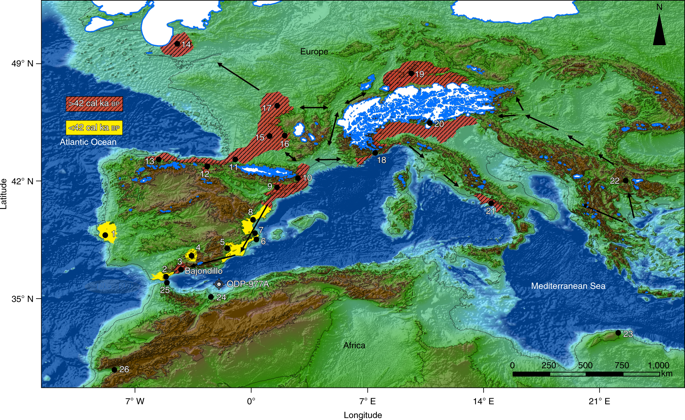Nature Ecology & Evolution ( IF 13.9 ) Pub Date : 2019-01-21 , DOI: 10.1038/s41559-018-0753-6 Miguel Cortés-Sánchez , Francisco J. Jiménez-Espejo , María D. Simón-Vallejo , Chris Stringer , María Carmen Lozano Francisco , Antonio García-Alix , José L. Vera Peláez , Carlos P. Odriozola , José A. Riquelme-Cantal , Rubén Parrilla Giráldez , Adolfo Maestro González , Naohiko Ohkouchi , Arturo Morales-Muñiz

|
Westernmost Europe constitutes a key location in determining the timing of the replacement of Neanderthals by anatomically modern humans (AMHs). In this study, the replacement of late Mousterian industries by Aurignacian ones at the site of Bajondillo Cave (Málaga, southern Spain) is reported. On the basis of Bayesian analyses, a total of 26 radiocarbon dates, including 17 new ones, show that replacement at Bajondillo took place in the millennia centring on ~45–43 calibrated thousand years before the present (cal ka bp)—well before the onset of Heinrich event 4 (~40.2–38.3 cal ka bp). These dates indicate that the arrival of AMHs at the southernmost tip of Iberia was essentially synchronous with that recorded in other regions of Europe, and significantly increases the areal expansion reached by early AMHs at that time. In agreement with human dispersal scenarios on other continents, such rapid expansion points to coastal corridors as favoured routes for early AMH. The new radiocarbon dates align Iberian chronologies with AMH dispersal patterns in Eurasia.
中文翻译:

奥里尼亚克人早期到达欧洲西南部
最西端的欧洲是确定解剖学上的现代人类(AMH)替换尼安德特人的时机的关键位置。在这项研究中,据报道,在Bajondillo洞穴(西班牙南部马拉加)的现场,奥里尼亚克工业取代了后来的穆斯特工业。根据贝叶斯分析,总共有26个放射性碳数据,包括17个新的碳数据,表明千禧年Bajondillo的置换发生在距今一千年(cal ka bp)校准的约45-43年的中心(校准 前)。海因里希事件4(〜40.2–38.3 cal ka bp)的发作 )。这些日期表明,AMHs在伊比利亚最南端的到达与欧洲其他地区的记录基本同步,并且显着增加了当时早期AMHs所达到的面积扩展。与人类在其他大陆上的扩散情景相一致,这种快速扩展指向沿海走廊,这是早期AMH的首选路线。新的放射性碳年代将伊比利亚的年代与欧亚大陆的AMH扩散模式相吻合。

















































 京公网安备 11010802027423号
京公网安备 11010802027423号